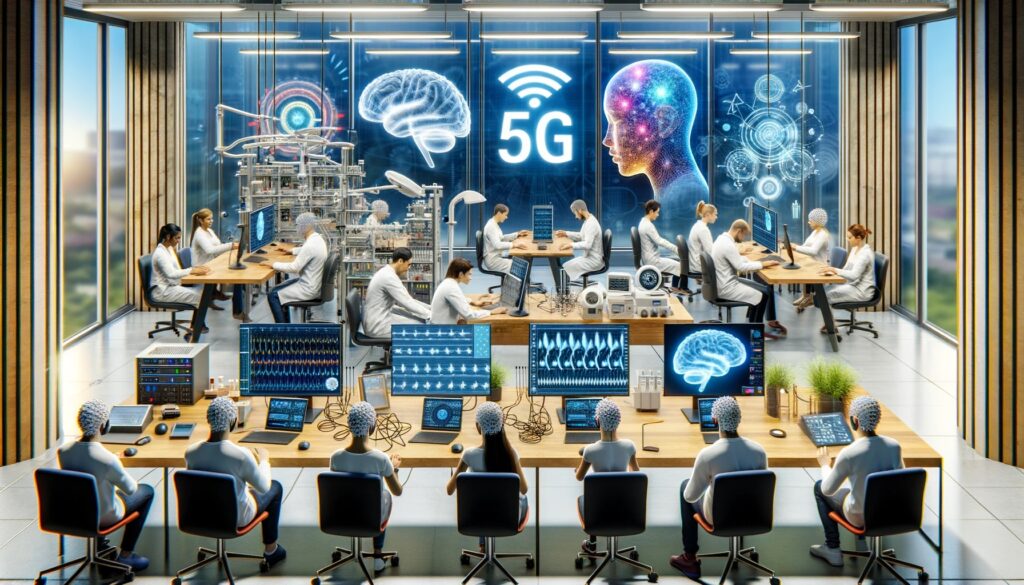This is the first time a study has been conducted to test the potential effects of 5G waves on the brains of young adults. As with previous studies on 4G and 2G technologies, no significant anomalies were detected.
Novel study in the face of lack of data
Due to limited data on 5G technology, a group of French scientists decided to study the short-term effects of high-frequency electromagnetic waves on the human brain. The results of this pioneering study, published by Sciences & Avenir, bring reassuring news: no physiological effects were found.
Brain remains unaffected by waves
5G, which is at least ten times faster than 4G, aims to speed up communications. The potential health effects of the higher frequencies (from 3.5 to 26 GHz, compared to 2.6 GHz for 4G) to which we will be gradually exposed are almost unexplored. Researchers at the National Institute for Environmental Health and Safety. Industrial Environment and Risk (Ineris) created an artificial electromagnetic field equivalent to 5G in a specially protected room, where they placed a volunteer for 25 minutes. During this time, they analyzed his brainwave response using an electroencephalogram (EEG). Thirty young, healthy adults took part in the study, and the results, published in the International Journal of Environmental Research and Public Health, confirmed there was no effect on the brain.
High frequency vs. tissue penetration
The study was based on data from South Korea, where 5G technology is much more widespread than in France. Data on electromagnetic exposure levels, used in a previous study by Brahim Selmaoui of Ineris, were used to faithfully replicate actual exposure. However, that study did not focus on the strongest 5G wavelengths, which can reach up to 26 GHz, such as in autonomous vehicle communications. “We can expect smaller effects because the higher the frequency of the waves, the less they penetrate tissue,” explains Brahim Selmaoui.
Effects of waves on the skin and nerve endings
Also of interest to researchers is the physical contact of this wave-transmitted energy with our skin and nerve endings, which is often raised by people claiming to suffer from electrosensitivity. Although, according to the French Health Safety Agency (Anses), 26 GHz frequencies cause “exposures mainly affecting the superficial layers of the body at probably low levels.” In the absence of sufficient data, it is difficult to know conclusively what the effects are. Research is underway into potential effects on heart activity, skin, and cognitive function and memory. It is also being investigated whether the waves could affect the occurrence of cancer or fertility.
Experts’ position
Most experts agree that at this stage, with no evidence to the contrary, our exposure is not expected to change dramatically with the introduction of new radiofrequencies. Similarly, previous studies on 2G, 3G and 4G technologies have not shown any tangible effects on the brain or health in general. Nor has the impact of the potential cumulative effect of the various waves been proven. However, for safety’s sake, it is recommended to keep the smartphone away from the ear when talking, using headphones or a hands-free set, and to place the Wi-Fi router outside the bedroom.
The development and widespread use of cell phones has sparked debates about their health effects. These devices use electromagnetic radiation in the microwave range, which has prompted numerous studies on the potential effects of electromagnetic radiation (PEM) on plants, animals and humans. The World Health Organization (WHO) has found no negative health effects associated with the use of cell phones.
Cell phones emit radio waves, some of which are absorbed by the user’s head. The power of the emitted waves depends on the network standard (e.g. GSM, CDMA) and is regulated by national standards, usually not exceeding 1-3.6 watts. A measure of radiation absorption by the body is the SAR coefficient, the maximum permissible level of which varies from country to country.
One of the studied effects of radiation is the thermal effect, i.e. tissue heating, which is much lower than during exposure to direct sunlight. Non-thermal effects, such as effects on the blood-brain barrier or electromagnetic hypersensitivity (EHS), remain controversial and poorly documented. Some studies suggest potential genotoxic effects of PEM, but most do not confirm the increased cancer risk associated with cell phone use.
Research projects, such as the international INTERPHONE project, have not found a significant link between cancer and phone use, although the results of some studies suggest an increased risk of brain cancer with long-term phone use.
Safety standards, such as those set by ICNIRP, regulate maximum levels of RF emissions to protect public health, but debate continues about their adequacy. Some countries have adopted stricter standards.
In conclusion, despite extensive research, there are still gaps in knowledge about the long-term health effects of microwave radiation from cell phones. Most of the current research findings do not indicate serious health risks, but continuing research and adjusting safety standards is essential in light of new technologies and the increase in their use.
What superstitions are around the health effects of 5G waves?
The introduction of the 5G network has coincided with the rise of various public concerns and myths about its impact on human health. This new communications technology, which offers significantly higher data speeds and reduced latency, has become the subject of intense debate not only in the technological context, but also in the health and environmental context. Below we look at some of the most widespread superstitions related to the health effects of 5G waves.
5G contributes to the spread of COVID-19
One of the most unexpected and untrue myths that emerged in the early days of the COVID-19 pandemic is the belief that 5G networks could contribute to the spread of the coronavirus. Conspiracy theories have suggested that the virus could be transmitted over a 5G network or that 5G infrastructure weakens the immune system, making people more susceptible to viruses. There is no scientific evidence to support these claims; coronaviruses are spread by respiratory droplets, not by telecommunications networks.
5G causes cancer
Another common myth concerns the belief that exposure to radio waves emitted by 5G antennas can increase the risk of cancer. Although radio waves are a form of electromagnetic radiation, they fall into the category of non-ionizing radiation, meaning that they do not have enough energy to directly damage the DNA of cells, unlike ionizing radiation such as X-rays or gamma rays. Studies to date have found no conclusive evidence of increased cancer risks associated with exposure to radio waves at levels emitted by telecommunications networks.
5G affects fertility
The superstition that 5G waves can negatively affect fertility is also finding its way into public discussions. This theory is not supported by sound scientific research. Most of the research in this area has focused on the broad spectrum of radio waves and their potential impacts, but the findings to date do not support a direct link between the waves emitted by cellular networks and negative effects on reproductive capacity.
5G is the cause of neurological disorders
There is also a group of people who believe that 5G networks may contribute to neurological disorders such as headaches, insomnia or even neuronal degeneration. Like other claims, there is no concrete scientific evidence to support these hypotheses. Research into the effects of mobile technology on neurological health continues, but so far no direct links have been found between 5G waves and neurological disorders.
5G affects weather and environment
There have also been theories that 5G networks could affect weather conditions or the environment in general. These arguments are based on the assumption that intense radio waves could affect bird migration or other aspects of nature. However, ecological research on the subject is still at an early stage, and scientific evidence to support these claims is minimal.
Myths and superstitions surrounding 5G networks are often the result of a misunderstanding of the technology and the human tendency to link unrelated events into cause-and-effect relationships. It is important to base opinions on solid scientific evidence and the results of studies conducted by credible institutions. Further research and education are key to dispelling myths and understanding the real impact of modern technologies on health and the environment.
https://youtube.com/shorts/gUXTFCmt-Vk?si=cuCECT5cXTWm2W6PElon Musk on 5G and phone radiation
Internet and health care
Internet usage in Poland
- More than 80% of Poles use the Internet.
- Nearly 90% believe that the Internet makes life easier.
The importance of the Internet in rural areas
- The Internet is especially important for residents of rural areas and small/medium-sized towns.
- 84% of Poles use the Internet, and 53% of them believe it makes life significantly easier.
Main benefits
- Communications, banking, news access and education.
- 70% of Internet users do most of their business online.
Trust in e-services
- In 2023, more than 1.25 million Poles will have set up a Trusted Profile.
- E-services popular for birth registration, ID card application and registration.
- Popular vehicle-related services: check penalty points, vehicle history (more than 68 million times).
Preferences of Poles
- 34% of respondents want greater use of the Internet in health and e-medicine.
- 83% believe that electronic enrollment in doctors and tests should be introduced as soon as possible.
Surfing devices
- Cell phones are used most often (86%).
- 52% of Poles would choose a smartphone as the only device with Internet access.
- Mobile Internet dominant in rural areas, fixed mainly at work.
Sources:
- Ondes 5G : voici ce qu’elles font à votre cerveau
- Internet and health care
- Health effects of cell phone radiation
- Elon Musk on 5G and phone radiation
- Survey conducted by Kantar Poland on behalf of the Ministry of Digitization, representative sample of Poles aged 15+ (N=1024).
Read also: What is the third wave in telecommunications infrastructure?



